What are the diseases of cucumber seedlings: photo and description
It would seem that what is easier - to grow cucumbers in the country. However, any business has its own nuances, and a good harvest takes effort. Dozens of diseases threaten fragile seedlings, many of which lead to the death of all plantings, make fruits inedible and damage the soil for a long time.
In the article, we will tell you in detail about the typical diseases of cucumber seedlings, their symptoms and treatment methods.
The content of the article
- The main signs of diseases of cucumber seedlings
- What are the diseases of seedlings and their descriptions
- Causes of cucumber diseases
- Seedling diseases treatment methods
- Basic rules for seedling care and disease prevention
- Conclusion
The main signs of diseases of cucumber seedlings
Many diseases affect plants so quickly and extensively that they can no longer be saved. To avoid this, it is worth foreseeing possible dangers in advance and getting to know the enemy by sight. Consider the first signs of disease.
Yellow streaks on the leaves
They appear along the edges and the entire surface of the leaves. Such symptoms signal a viral infection of the plant.
Seedlings fall and wither
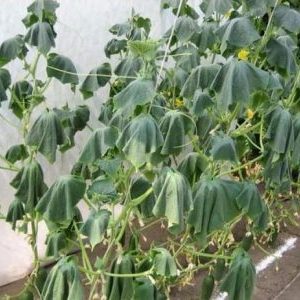 If drooping seedlings are found, take a closer look - there is no thinning of the stems. Seedlings of cucumbers can fall with a fungal infection.
If drooping seedlings are found, take a closer look - there is no thinning of the stems. Seedlings of cucumbers can fall with a fungal infection.
Rolling the leaves
Withering of seedlings often occurs with leaf rolling. This is the result of a lack of moisture or trace elements in the soil.
Seedling development lag
This symptom appears when the root dies off and in the absence of apparent reasons. In the future, the plant dies.
What are the diseases of seedlings and their descriptions
There are about 20 types of common diseases of cucumber seedlings. Improper care, insufficient soil nutrition and many more factors contribute to fungal infections, bacterial and viral infections.
Diseases of fungal origin
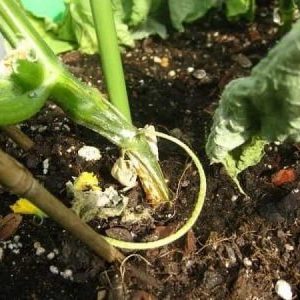
Diseases caused by fungi affect cucumber seedlings most often. They are caused by fungi of the genus Pythium Pseudoperonospora, Fusarium, oxysporum f. nveum, Thielaviopsis basicola, Erysiphe cichoracearum, Pythium.
Powdery mildew
A disease that mostly affects greenhouse cucumbers. It starts with the appearance of a white bloom on the underside of the leaves. Then the leaves change shape, the cucumber fruits begin to taste bitter, and the plant itself withers.
Peronosporosis (downy mildew)
Affects stems and leaves. Oil spots appear first, which later turn brown and the leaves dry out.
Root rot
You can notice the disease after planting seedlings. Symptoms - lethargic leaves, yellowed stems, frozen ovaries.
White rot (sclerotinia)
The disease manifests itself in foci of infection with white mycelium, later they turn black. The stems are watery.
Gray rot
First symptom - the appearance of brown, vague, slippery spots on the leaves. In the future, the fruits are covered with spots. Cucumbers become watery and soft, and a gray fluff (spores) appears on them.
Black rot (ascochitis)
It manifests itself during fruiting or during the formation of the stem. It begins with the appearance of gray watery spots on the stem. Then the leaves are affected, first along the edges, and then over the entire surface.
Black mold
This disease affects all aerial parts of the plant. Small brown spots of various shapes appear on the leaves, then they merge and turn into necrotic spots, around which brown rims appear. The leaves die off, and the rest of the seedlings are covered with a spider web.
Anthracnose (copperhead)
Disease pursues cucumbers throughout the growing season. Yellow or brown spots appear on the edges of the lower leaves and between the veins. The leaves turn yellow, their functions are disrupted, and then the stems begin to suffer. The fungus affects the tissue of the fetus to a depth of 3-4 mm.
Cladosporium (Olive Spot)
One of the most dangerous diseases affects weakened plants. The fruits are covered with brown wet sores, after which they cannot be eaten.
Rhizoctonia
This fungus infects the cotyledon leaves near the root necks by forming small yellow-orange spots. Fruits and petioled leaves that touch the soil are infected. Spots also appear on the tops of the fruits. The plant dies in the seedling stage.
Tracheomycosis
The disease of wilting cucumbers is divided into fusarium and verticillosis.
- Fusarium... An extremely dangerous disease. It is manifested by wilting of cucumber lashes. Fungal infection affects the vessels of the plant. On the cut of the stem or leaf, you can see that they have a brown tint. The plant rots from the base of the root, the stem becomes thinner, darkens, the leaves turn yellow;
- Verticillosis... Also manifested by wilting of cucumbers. It starts with unilateral wilting of the leaves, then the whole plant wilts.
Alternaria (dry spot)
Greenhouse cucumber disease. First, dry brown spots of a convex shape are formed on the lower leaves, then they merge into large formations. Gradually, the leaf plates die off. The disease does not spread to the stems.
Important! To reduce the risk of infection with fungal infections, properly prepare the soil. Signs of a healthy soil are thorough disinfection and full air permeability.
Diseases of bacterial origin
Both in the greenhouse and in the open field, cucumbers can be infected with bacterial infections. Diseases are carried by seeds and plant debris. Wind, rain and insect pests can also transmit the infection.
Angular spotting of leaf plates (bacteriosis)
The causative agent is a bacterium of the pseudomonas family of the actinomycete class. It is found in soil and water, sometimes in the human body and food. The toxin released by bacteria infects the epidermis of living organisms. In cucumbers, this is a foliage. Brown spots form on the leaves, then necrosis occurs. Disease affects up to 90% of leaves, stems and fruits are partially affected.
In the photo there are leaves affected by bacteriosis.
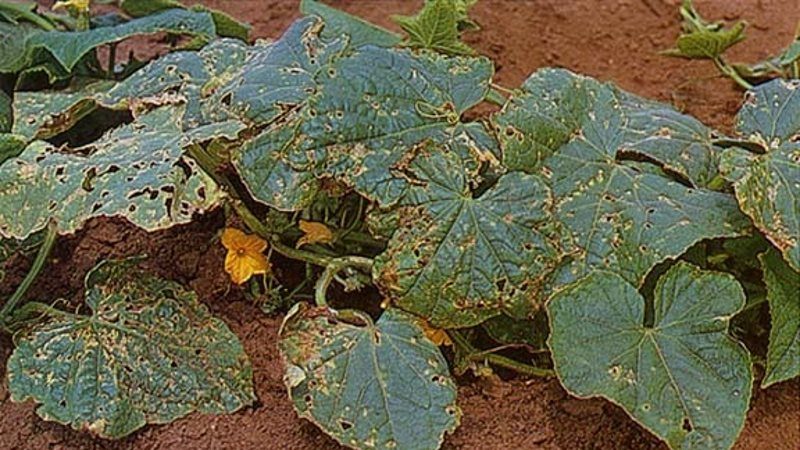
Diseases of viral origin
Viral diseases of cucumbers affect plants at the cellular level. Pathogens viruses Cucumis virus 2A, Cucumber mosaic cucumovirus (CMV), VZKMO, Tobacco necrosis virus. Viral diseases include different types of mosaics. Most often, the disease affects cucumbers in greenhouses.
Mosaic white
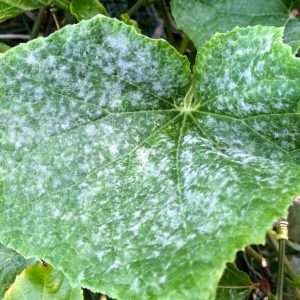 The first symptom is blurry yellow-white spots in the form of stars or rings near the leaf veins. Further, the color of the spots changes to greenish-white, then the entire leaf becomes white.
The first symptom is blurry yellow-white spots in the form of stars or rings near the leaf veins. Further, the color of the spots changes to greenish-white, then the entire leaf becomes white.
Mosaic green
The disease is characterized by the appearance of a light green spot, deformation of leaves and fruits. The virus invades the stems and root system and destroys the plants.
Ordinary mosaic
It appears on young seedlings. The leaves are wrinkled and covered with mosaic specks of a light green hue. The edges of the leaves curl up, the plant stops growing.
Viral necrosis
It appears on the cotyledons with pale yellow necrotic spots in the circle of the green zone. Withering and dying off of leaves is observed, deformation of fruits, on which spots are also formed.
Causes of cucumber diseases
Knowing all the diseases of cucumbers is only half the battle. For successful treatment, you need to know the reasons that cause them.
Improper care
Cucumber loves warmth. Violation of the temperature regime is fraught with various plant diseases. The optimum temperature for a cucumber is 20-25 ° C. At elevated temperatures or drops, the seedlings become vulnerable to diseases, especially fungal ones. When growing cucumbers in a greenhouse, you need to create optimal temperature conditions for them.
Another important indicator is the level of soil moisture. High humidity provokes bacterial diseases in cucumbers.
At low humidity, the plant loses its immunity, which also contributes to the development of diseases. Moisture is easier to track with any growing method. It is enough to control watering. There is a special moisture meter to determine the indicators.
Important! The optimum soil moisture level is 70-80%.
Weeds and last year's plant residues can be sources of disease. Be sure to dispose of them immediately upon discovery. Disinfection of seeds is also mandatory. They are infected with pathogens.
Lack of nutrition
It is not enough to create favorable conditions for the growth of cucumbers, they must be fed with fertilizers, the lack of which directly affects the yield.
Potassium is responsible for the formation of fruits. The first sign of a lack of potassium is yellowing and falling leaves. In the future, the fruits acquire a hook-shaped shape. At this stage, the plant can no longer be helped.
With a nitrogen deficiency, cucumbers stop growing. The fruits remain small and yellowish and are carrot-shaped.
In the case of a lack of phosphorus, the plant grows large, but the fruits remain small and lose their taste.
It is also necessary to feed the plant with microelements, without this it will not be possible to grow good and tasty cucumbers.
Insect pests
The most likely seedling pests:
- spider mite sucks juice from leaves;
- whitefly - from the abundance of its larvae, the leaves wither and become covered with a gray bloom;
- slugs eat any part of the plant;
- ants gnaw at roots;
- melon aphid feeds on the sap of leaves and stems.
Seedling diseases treatment methods
Like other garden crops, cucumbers treat diseases with biological, chemical and folk remedies.
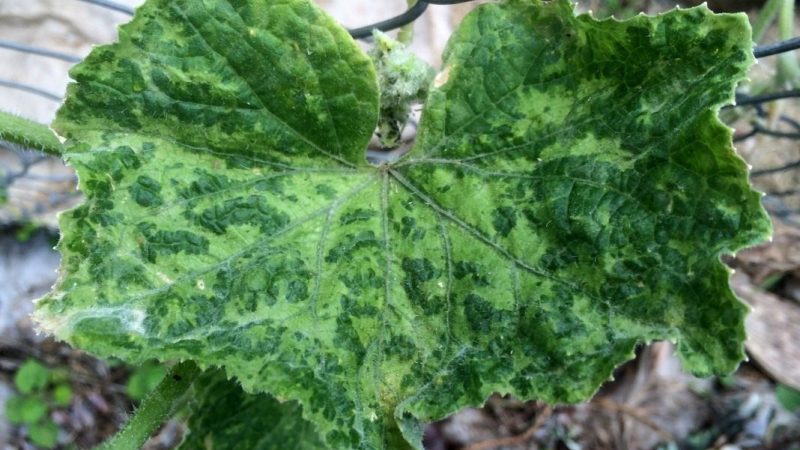
Folk remedies
- 2 g of potassium permanganate is diluted in 10 liters of water and sprayed with plants.
- 30 g of crushed garlic is poured into 1 liter of water and left in a cool dark place. Before spraying, the tincture is diluted in 9 liters of water.
- 1 liter of whey is diluted in 10 liters of water and the plants are treated.
- 60 ml of 3% perhydrol is diluted in 3 liters of water and sprayed.
- The tobacco mixture is sprayed onto the moistened leaves.
Chemicals
Chemicals include fungicides and insecticides. Fungicides are used to fight diseases, insecticides destroy harmful insects. Treatment with chemicals is carried out during the growing season of cucumbers, but no later than 21 days before the start of harvesting. They use chemicals strictly according to the instructions and observe precautions.
The best fungicides are Sandofan M8, Acrobat MC, Oksikhom, Strobi.
From effective insecticides, you can choose "Actellik", "Kuproksat", "Fufanon", "Confidor", "Fitolavin 300".
Biological agents
Biologicals are added to the soil to protect cucumbers from diseases. Spreading in the soil, they release substances that inhibit the development of diseases. Such drugs have proven to be a reliable means for the prevention and treatment of diseases, especially root rot.
The most effective means: "Alirin B", "Glyokladin", "Gamair", "Vitollan SP", "Trichocin SP".
Important! Cucumbers most often get sick at the flowering stage, therefore, preventive treatment is best done before the flowers appear.
Basic rules for seedling care and disease prevention
The key to a good harvest is proper seedling care. After planting in the ground, healthy seedlings have strong root and aerial systems and are less susceptible to disease.
Top dressing
Seedlings are fed at least twice. The first time is two weeks after the emergence of seedlings, then, when the second true leaf grows.
2-3 days before planting in the ground, the seedlings are fed again.
Fertilizers are applied in the morning along with watering strictly to the root. They should not fall on the stem and leaves.
The most commonly used fertilizers are "Breadwinner", "Fertility", sodium and potassium humate, "Nitrofoska".
Picking
While the seedlings are small, they develop well in the general capacity.... As the root system develops, each plant needs more space. To do this, a pick is carried out - the transplant of babies into separate containers with a soil mixture. It is carried out in the early stages of growth, when the cotyledon leaves have fully opened and real leaves have appeared. Small plastic cups are suitable as containers. Drainage holes are made in them and filled with a substrate a day before the dive.
Before transplanting, the seedlings are watered abundantly and taken out one at a time with a small clod of earth using a small spatula.
Depressions are made in containers and seedlings are placed in them to a depth of cotyledonous leaves. The leaves should not touch the soil, otherwise the seedlings may rot.
Important! The pick is carried out extremely carefully so as not to damage the thin roots of the seedlings.
Conclusion
With all its advantages, cucumber is a culture vulnerable to fungal, bacterial and viral diseases. In order not to put plants at risk, follow the rules of care, learn to recognize diseases at the first sign and know the best methods of treatment. Then the grown crop will be able to please with its abundance and delicious fruits.